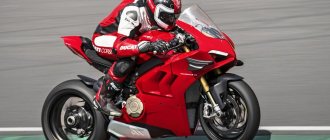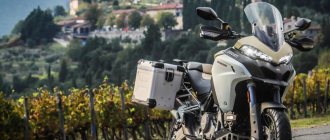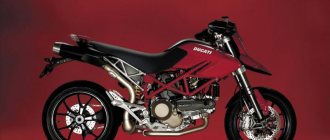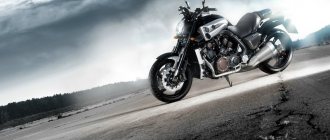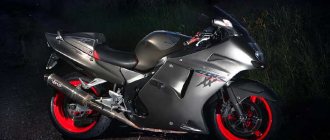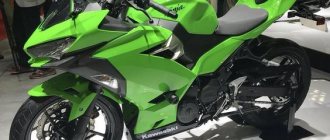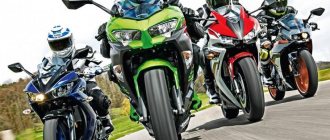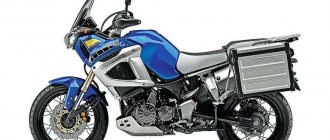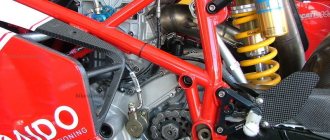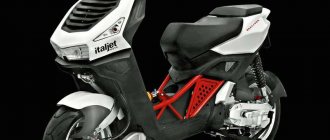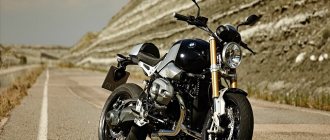000_moto_0112_010
Compared to last year's Ducati 1198, the new Panigale is 10 kg lighter and 25 hp more powerful.
Compared to last year's Ducati 1198, the new Panigale is 10 kg lighter and 25 hp more powerful.
They say that when the Japanese first saw the “shishiga” (GAZ-66), they clicked their tongues for a long time and groaned in admiration: “Whatever the Russians can come up with, just so as not to build roads!” Studying the design of the Ducati 1199 Panigale, I want to repeat after them: “Whatever the Italians can come up with, just so as not to switch to four cylinders!” It's scary to think how Ducati would crush its rivals if it released a four-cylinder motorcycle. But it worked out well with two. How long have we admired the 1:1 power ratio? And the Panigale has 195 hp. power for 165 kg of dry weight! And even equipped - only 188 kg.
In their L-twins, Ducati specialists consistently used all possible overhead camshaft drive schemes: first with shafts and bevel gears, then with a belt, and now they have finally switched to the generally accepted chain drive scheme. Well, the headaches for mechanics will clearly be reduced (by the way, the stated service intervals are 24,000 km). Another revolutionary change in engine design was the transition from roller main bearings to plain bearings: this solution made it possible to increase the size of the crankshaft journals without “inflating” the crankcase.
So Ducati experts are not lying when they say that all that remains from the previous engines in the new Superquadro is a desmodromic valve drive and an L-shaped cylinder arrangement with a camber angle of 90º. However, L is already conditional: in an effort to move the power unit forward and thereby load the front wheel, the engineers “twisted” it back, so that the front cylinder rose 21º from the horizontal. The classic V is not too far away! Weight distribution with a driver of average fatness - 52/48%.
Another fundamental innovation is reflected in the very name of the engine: Superquadro, “super square”. The dimensions of the unit are 112x60.8 mm (for comparison, the previous 1198 had 106x67.9 mm). The large cylinder diameter made it possible to increase the valve sizes: intake from 43.5 to 46.8 mm, exhaust from 34.5 to 38.2 mm. To reduce the mass of these “plates”, we had to switch to a titanium alloy. Well, the desmodromic drive turned out to be just right. The engine design uses a centrifugal decompressor to facilitate starting, the mechanism of which is built into the exhaust camshafts, and a vacuum pump in the crankcase. It sits on the same shaft as the oil pump and creates a vacuum in the cavity under the pistons, reducing pneumatic losses (a solution widely used in MotoGP engines). The cylinders are cast integrally with the crankcase parts; “wet” aluminum liners with nickasil coating are inserted into them (this solution increases the rigidity of the unit, improves sealing and heat dissipation).
For the first time on Ducati superbikes, the transmission has abandoned the dry clutch. Now it works in an oil bath, and a mechanism known from Monster is used: when the speed increases, the discs are additionally pressed against each other, which allows the springs to be slightly weakened and thereby reduce the squeezing force.
The power unit is the main load-bearing element of the chassis. Attached to the cylinder heads is what remains of the frame - a cast aluminum monocoque, which also serves as an air filter housing. Connected to this is a magnesium alloy front subframe that holds the fairing, headlights and instrument panel. The axis of the rear suspension pendulum passes through the crankcase of the power unit. The horizontal monoshock absorber is shifted to the side - this way the designers not only freed up space for the rear cylinder of the engine, but also provided easy access to the settings. By rearranging the mounting points, you can change the degree of suspension progression - from maximum for riding with a passenger to linear for track rides.
In terms of electronics, the Ducati Panigale leaves all other sportbikes far behind. Firstly, there is eight-position DTC traction control - its switch is located at the left handlebar grip. Secondly, the DQS quick shifter allows you to shift up without releasing the gas. Thirdly, the EBC electronic engine braking control system - by analyzing sensor data, it prevents the throttle valves from being completely closed if there is a threat of locking the rear wheel (interestingly, it works in conjunction with a slipper clutch). Fourthly, ABS. Fifthly, the DDA+ data collection system, which is now equipped with a GPS sensor: on the track you just need to press the “flashing light” button on the start-finish line once for the system to count the laps itself. Sixthly, DES suspensions with electronic hydraulic adjustments. Finally, there is a mode switch that affects not only the engine, but all the electronic systems of the motorcycle - just like on the Ducati Multistrada. In Race mode, there is the most acute response to the movement of the throttle, the suspension is “clamped”, the racing settings of the engine braking system are turned on, ABS affects only the front wheel, and the appearance of the instrument panel changes. In Sport mode, the response to the throttle is smoothed out, the suspension and engine braking system switch to a softer mode, the intervention of the traction control system increases, ABS acts on two wheels and combats the lift of the rear wheel during heavy braking. In Wet mode, the maximum power is reduced to 120 hp, the throttle response is the smoothest, the suspension settings are optimized for poor grip, the quick shifter is disabled, traction control, engine braking control and ABS work "to the fullest." However, the driver himself can get into the settings menu for all systems (the display is a dashboard on TFT thin-film transistors) and configure the mode to his own taste.
The Ducati Panigale is available in three equipment variants. The base model has fully adjustable suspension (Marzocchi front fork and Sachs rear monoshock), but with manual adjustments. ABS and the DDA+ data acquisition system are installed at an additional cost. The Panigale S version is equipped with electronically adjustable suspension: Ohlins NIX30 front fork and Ohlins TTX36 rear monoshock. In addition, this version differs from the base version with LED headlights, forged Marchesini wheels and a carbon fiber front fender. On the top version of the Panigale S Tricolore, painted in the colors of the Italian flag, all options, including ABS and DDA+, are included in the equipment. In addition, the machine is equipped with an exhaust system made of titanium alloy.
How much does all this splendor cost? In Italy, the base Panigale costs 19,190 euros, the S version costs 23,990 euros, and the Panigale S Tricolore costs 28,990 euros. That is, the new family is 10–15% more expensive than the discontinued “1198”. The price ratio in our market will be approximately the same.
TEST DRIVE: Ducati Panigale 1199 (2012) – PULLER
The full test drive of the Ducati Panigale 1199 (2012) took place in February at the stunning Yas Marina Circuit in Abu Dhabi. The track was chosen appropriately! But how good the representative of the new wave of superbikes of the 21st century is was tested by three-time world champion Troy Bayliss and our test pilot Thor Sagen.
MOTOGONKI.RU, March 11, 2012 —
Instead of a preface.
The introduction of the Ducati Panigale 1199 is a major push factor for superbike manufacturers. If the market does not face a serious shock in 2012, we can expect significant technological re-equipment, if not revolution, in the fall. The superbikes that companies produce (especially Japanese ones) are obsolete. The concepts contained in them are 18-20 years old. For decades, motorcycles were polished for highway riding, but as sports equipment they reached their limits in 2008, after which the development of the most technologically advanced and profitable segment of the market stopped. Remaining a popular and fairly high-quality mass product, bikes from the Land of the Rising Sun began to lose the battle to Europeans on race tracks. New applicants appeared one after another. The Aprilia RSV4 and BMW S1000RR forced the Japanese old-timers out of the garages, and Ducati began to squeeze in as well.
With the release of the 1199 Panigale, the plant intends to regain its status as “No. 1” in the field of innovation and top technologies for sports. To sell expensive superbikes, production quality alone is no longer enough: the client chooses a bike from several of approximately equal capabilities, and racks his brains - how not to make a mistake? This is a relevant remark when you shell out 25 thousand euros for “consumables”. What if we are talking about equipping an entire team? Once the choice is made, there is no turning back.
Ducati's decision to implement MotoGP technology virtually unchanged into a production bike is bold and timely. Elements such as the aluminum monocoque chassis with a monocoque engine, fully customizable suspensions and an engine built in the image of the Desmosedici are no longer prototype parts! That is why the launch of Panigale is so important and interesting, and the rest of the players are closely monitoring what is happening and drawing conclusions.
In February, at the Aprilia World Superbike presentation, Max Biaggi mentioned that Noale was developing a “new” RSV4. In the autumn, at EICMA, the plant may give an answer to Panigale. This is also what Aprilia did in the past when they developed the RSV Mille: the bike was completely updated every 5 years. In 2013, new items are expected in the Japanese lines. Suzuki is developing a concept that will replace the GSX-R. It is known that the same engineers who worked on the GSV-R for MotoGP are working on it. Kawasaki's R&D center continues to evolve the ZX-10R program from "a race bike to a road bike, not the other way around," as project manager Ichiro Yoda said. Today the Ninja could become the biggest entry on the World STK-1000 grid. But no competitor will have a second Panigale in 2012.
Three-time world champion Troy Bayliss and our test pilot Thor Sagen checked how good the representative of the new wave of superbikes of the 21st century is. [nxtpage]
This entire text is pure emotion.
Don't look for logic in many statements, just believe: Panigale is an atomic bomb in the hands of an experienced person. I felt well what pressure is. Air pressure when accelerating to 250 km/h. My Suomy Apex literally stuck to my face when the numbers “240” appeared on the speedometer, and my ears were blocked due to the strong crosswind. Or was it not the wind, but the air currents that my Ducati Panigale cut through - the quintessence of developments for World Superbike of the last three years?..
The acquaintance with the 1199 began with a joint trip to the track with an incredible person and an extraordinary test pilot of our time - technical director of Ducati MotoGP Vito Guareschi. During the test, not without false modesty, he noted that he was the only one in the group who could keep up with his pace. Many factors held us back that day. And a flock of pigeons circling too low over the Yas Marina Circuit, and sand on the main straight that had drifted in from the desert overnight. Vito knocked down one pigeon on the second lap, I cleaned up the other, trying to accelerate the Panigale to 300 km/h...
When we talk about high speeds, we mean it because this is the Yas Marina with its 1.2km main straight where the Formula 1 guys shift into 7th gear to reach top speed. On the Panigale, you have only two desires: at the beginning of the straight, keep full throttle and stay in the saddle with all your might, and at the end, pray that the brakes will fulfill their mission. A small braking zone on the way down a hill leads into a tunnel, and there is no desire to meet its wall at a speed well over 200 km/h.
We were able to try and compare both versions of Panigale – with and without the letter “S”. The Ducati guys said the Termignoni exhaust adds "some" 8 hp to the bike. to its base 195, that is, 203 hp. with a dry weight of 164 kg. This, I must say, is such a force that can shake the whole soul out of you, figuratively speaking. So over time I had to... keep a close eye on my right hand, control it against over-throttle, just to keep a steady pace and improve my lap times. Because if you don't, the Panigale, according to three-time WSBK champion Troy Bayliss, "simply blows you away at 310 km/h." I only saw 270 on my speedometer because then I had to look for the braking marks.
Do you know why I don’t quit being a test pilot? Every time the factories surprise us with something. Every time we present such motorcycles, they bring us joy. And the new Ducati Superquadro is definitely the most powerful and high-tech engine I've ever tried.
The Panigale is also incredibly agile in corners. The guys from Ducati deliberately dragged us to Abu Dhabi, because this entire track consists of a huge number of connections where we have to work without a break. And even the starting line would not give a reason to relax. But the 1199 steers perfectly. What can this feeling be compared to? If you've driven a BMW S1000RR on the track... the Panigale handles much better! It is better in weight distribution, power delivery, and electronics. These are just feelings, and if I succeed, I will definitely do a head-to-head comparison test.
The monocoque frame migrated straight from MotoGP. For the first time since 1994, Ducati is not building a Superbike based on a birdcage. And one of the main positive effects of this replacement was the incredible agility of the motorcycle in corners, thanks to the delicate centralization of mass and balance of the design. Shifting the bike from full left lean to full right lean is no comparison to the 1198: to everyone's surprise, Ducati has created a super-manoeuvrable superbike that you don't need to be a comic book superhero to ride. The only thing that hinders the handling of this bike is its powerful engine, which would easily tear off the rear wheel if the Panigale weren't equipped with electronics, top quality suspension and grippy Pirellis.
I saw what Troy did the day before. In my opinion, he rode in a wheelie on the front wheel, and went into a stoppie on the back. Only Chuck Norris is cooler... I'm sure it's possible while driving a Panigale. Everything about the bike's design, from the frame and aerodynamics to the Ducati-specific Pirelli Supercorsa tires, is designed for stability at high speeds. Heavier bikes like the Hayabusa might have been more stable, but they would never have been superbikes.
Everything about Panigale is special. The new Brembo Monoblock 50M calipers are not in the usual configuration, they are slightly reduced in proportion to the size and weight of the bike. On the Panigale S, the 330mm brake discs are positioned 15mm to the side for better cooling. The handlebar also doesn't look like a traditional one because it's taller and wider. Of course, not in the Motard style, no... But this minor detail allows the pilot to cope with the power of the engine even when braking. I realized that the motorcycle allows you to brake very hard, even from speeds over 200 km/h, while maintaining stability and straightness, the tension in the muscles is much less when compared with the Ducati 1198SP. I passed the simplest test for “tremor” when drinking another cup of coffee. This is generally good news, because such exercises are always a game on the verge of real physics. But even with EBC switched to level one, it was possible to wag the tail, lifting the rear wheel into the air before cornering. I actually liked riding this style, it seems that MotoGP pilots follow the same religion.
I'm impressed with how Panigale interpreted my actions. The basic version of the Panigale S is equipped with a “racing” ABS unit, which means that there are stall sensors only on the front wheel, the rear brakes are a conventional analogue system. And this is the only ABS system that I would recommend for use with any road tire, including Pirelli Supercorsa. With SC2 series slicks, ABS could be turned off completely. Ducati allows you to “stop” beautifully on well-heated slicks; the anti-block works much later than on other systems. And that's good, from my point of view. [nxtpage]
Working with the Ducati Panigale gave me the confidence needed to perform well in braking. After the second session, I knew for sure that in the event of an unsuccessful overtaking or to prevent an incident, I could work with them much more actively than under normal conditions. I would brake as late as possible. But, alas, Yas Marina is a track that promotes a smooth and beautiful ride rather than diving into corners with wheels falling off. This is the only way to achieve a truly high average speed. In tight corners I just fell in love with the Panigale because the bike always ended up exactly where I wanted to be. At the same time, I clearly understood that if I was a little late with braking, and then opened a little earlier, nothing terrible would happen, I would just personally be a little more tired! But not a motorcycle. Traction control no longer takes the initiative, and you receive all the information about what is happening on the wheels from the steering wheel. Just make sure the front wheel is still on the pavement, and then you can follow any path and lean the bike at any angle. In particular, the extended rear wheel console is responsible for the stability of the motorcycle during acceleration. This part, attached directly to the engine, is one of the most important in the design. The new console design, which still weighs only 5.1 kg, saves energy.
The 1199 Panigale S is equipped with high-precision Ohlins electronically adjustable suspension. If there was a little less sand on the track, I would use the firmest setting from start to finish. In particular, I was struck by the high information content of the rear TTX36, which seemed to directly connect my head and the Pirelli Supercorsa SP 200/55-ZR17 tire. I deliberately used only first gear in the corners in order to put maximum load on the rear wheel and tear it off. Still 203 hp. We should have done this, but during the whole time I only once noted the exit to a long slide in a turn. After all, if you think like a racer, this would reduce the average speed of the track. And the only reason why I still switched to second gear was the fight against the wheelie. Pro riders would probably solve this issue by using the rear brake and opening the throttle wider...
Shifting in the 6-speed gearbox is made extremely easy thanks to the Ducati Quick Shifter: with it you can shift up at full throttle without any second thoughts. The dashboard is very informative. The orange traction control indicator is quite informative and will be useful during training. DTC is very active in Race mode, where the system's base engagement level is "3".
Having only an hour of track time, there is always a feeling that there is a whole abyss separating you from the full disclosure of the topic. In the case of the Ducati 1199 Panigale S, I would probably have needed a lot more time to improve the Yas Marina. So I tried to focus on the ride itself, rather than on the technical ideas that Ducati embodied in this miracle (their representatives of the factory repeatedly published in press releases).
Total
Wow! What a day I experienced today! The Superquadro engine is as brutal as I like it. And I am absolutely confident when I say that the Ducati 1199 Panigale S is the pinnacle of motorcycle engineering! Buy a bib soon, you'll need it to survive the long wait for the Panigale to arrive in showrooms. This is a “must have” motorcycle for the next three years.
Pros:
+ Superquadro V2 is impressive and good in its own right. + The chassis is radically improved compared to the 1098 series. + Unrivaled electronics package + Basic ABS system - not for old farts!
Minuses:
— Price is around 23,300 euros for the “S” package with ABS
Full text, technical specifications of the Ducati Panigale 1199, exclusive photos from Yas Marina published in the March issue of RACEMAG . Read ON-LINE - it's free!
Translation and introduction: Kirill Chernyshev Photo: Milagro
016_moto_0112_010
Visitors to the Milan Motor Show EICMA-2011 named the Ducati Panigale the most beautiful motorcycle of the exhibition.
Visitors to the Milan Motor Show EICMA-2011 named the Ducati Panigale the most beautiful motorcycle of the exhibition.
| TECHNICAL SPECIFICATIONS Ducati 1199 Panigale (manufacturer data) | |||
| Model | 1199 Panigale | 1199 Panigale S | 1199 Panigale S Tricolore |
| COMMON DATA | |||
| Model year | 2012 | ||
| Curb weight, kg | 188 | 190,5 | |
| Length, mm | 2075 | ||
| Base, mm | 1437 | ||
| Seat height, mm | 825 | ||
| Reach, mm | 100 | ||
| Steering column tilt angle, degrees. | 24,5 | ||
| Gas tank volume, l | 17 | ||
| ENGINE | |||
| Type | V2, 4T | ||
| timing belt | DOHC, 4 valves per cylinder | ||
| Working volume, cm³ | 1198 | ||
| Cylinder diameter × piston stroke, mm | 112×60,8 | ||
| Compression ratio | 12,5:1 | ||
| Max. power, hp at rpm | 195/10750 | ||
| Max. torque, Nm at rpm | 132/9000 | ||
| Supply system | fuel injection, two injectors per cylinder | ||
| Cooling system | liquid | ||
| Starting system | electric starter | ||
| TRANSMISSION | |||
| Clutch | multi-disc, oil bath, with reverse slip | ||
| Transmission | 6-speed | ||
| main gear | chain | ||
| CHASSIS | |||
| Frame | monocoque, aluminum alloy | ||
| Front suspension | Marzocchi inverted telescopic fork, fully adjustable | Ohlins inverted telescopic fork, fully adjustable, electronic hydraulic adjustments | |
| Pipe diameter, mm | 50 | 43 | |
| Wheel travel, mm | 120 | ||
| Rear suspension | pendulum, with progressive characteristics and fully adjustable Sachs monoshock absorber | pendulum, with progressive characteristics and fully adjustable Ohlins monoshock absorber, electronic hydraulic adjustments | |
| Wheel travel, mm | 130 | ||
| Brake system | separate, hydraulic, optional - with ABS | separate, hydraulic, with ABS | |
| Front brake | two Ø 330 mm discs, monobloc 4-piston Brembo M50 calipers | ||
| Rear brake | disc Ø 245 mm, 2-piston caliper | ||
| Wheels | cast, aluminum alloy | ||
| Front tire | 120/70ZR17 | ||
| Rear tire | 200/55ZR17 | ||
PA-NI-GA-LI: Ducati 1199 Panigale
